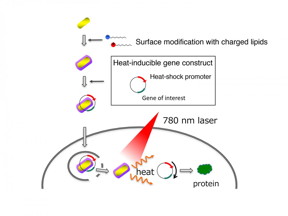Killing cancer in the heat of the moment: A new method efficiently transfers genes into cells, then activates them with light. This could lead to gene therapies for cancers
Mineko Kengaku, Tatsuya Murakami, and their colleagues from Kyoto University's Institute for Integrated Cell-Material Sciences (iCeMS) have developed a new method that modifies the surface of nanorods, making them more efficient in transporting cancer-killing genes into cells.
he method involves coating gold nanorods, which produce heat when exposed to a near-infrared laser, with the lipids oleate and DOTAP. The lipids enhance the nanorods' ability to interact with and penetrate cells.

This is the delivery and activation of genes by gold nanorods. Gold nanorods coated with charged lipids efficiently bind to DNA and penetrate cells. The team designed an artificial gene that is turned on by heat generated by the gold nanorods upon exposure to near infrared light illumination.
The team also developed a gene carrier, known as a plasmid vector, which includes a 'heat shock protein' that is activated in response to heat.
First, the vector was bound to the 'enhanced green fluorescent protein' (EGFP) gene, and then transferred into mammalian cells by the lipid-coated gold nanorods. Exposing cells to near-infrared laser for ten seconds heated up the gold nanorods, turning on the EGFP gene. Surrounding, non-targeted cells showed little to no EGFP expression.
A protein called TRAIL was then added to the plasmid vector. TRAIL induces cell death in cancer cell lines. Infrared illumination of cells transfected by TRAIL-carrying nanorods led to a high cell death rate in surrounding cancer cells.
The lipid-coated gold nanorods could potentially help with molecular cancer therapies.
This new system "provides a unique opportunity for site-directed, light-inducible transgene expression in mammalian cells by a near-infrared laser, with minimal phototoxicity," conclude the researchers in their study.
Source: Nanotechnology Now
- 394 reads
Human Rights
Ringing FOWPAL’s Peace Bell for the World:Nobel Peace Prize Laureates’ Visions and Actions

Protecting the World’s Cultural Diversity for a Sustainable Future

The Peace Bell Resonates at the 27th Eurasian Economic Summit

Declaration of World Day of the Power of Hope Endorsed by People in 158 Nations

Puppet Show I International Friendship Day 2020

